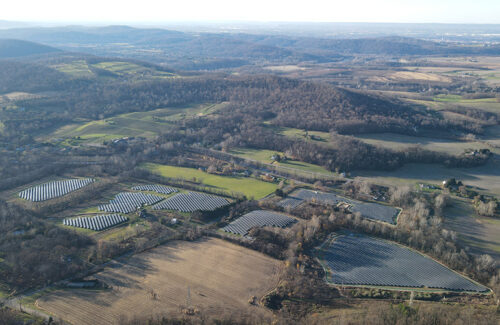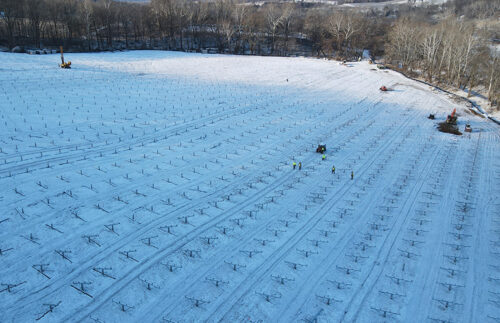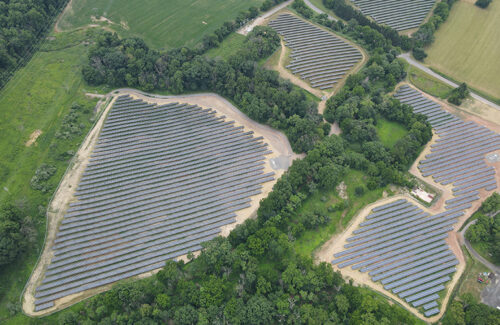In 1907, a paper mill was built in Milford Township, New Jersey, to process wood, convert it into pulp, and convert it into food-grade paper. This factory operated until the 1990s, changing names and ownership several times before being completely abandoned and closed in 2003.
Fifteen years after the Milford paper mill officially closed, the site was developed by New Jersey-based company CEP Renewables for a solar project that turned a post-industrial tract into a power plant for the nearby community and larger Hunterdon county.
Recent clarifications on Energy Community tax surcharges in the Inflation Reduction Act could help encourage more projects to be built on land like the Milford paper mill. Land designated as a landfill, brownfield site, Superfund site, or decommissioned fossil fuel power plant may be eligible for solar projects and associated job creation and tax benefits.
A two-phase, 17 MW solar project took the place of a long-defunct paper mill in New Jersey. CS Energy
Although built before the Energy Community loans, the Milford Paper Mill Array demonstrates the economic and environmental potential of this type of solar project for communities. 
"One of the biggest impacts is the property coming back to the tax role," said Chris Ichter, executive VP of CEP Renewables. "A property that sits there as a liability then turns into a revenue stream. That's a huge thing for the community to generate electricity on-site."
But turning a disused paper mill into a two-phase, 17MW solar project was no small feat. The property was owned by the New Jersey Dept. of Environmental Protection (NJDEP) as a brownfield site due to "illicit discharges" of environmentally hazardous materials. The Environmental Protection Agency found that much of the site was contaminated with polychlorinated biphenyls, a cancer-causing chemical that lingers in the soil, air and water without breaking down. Some of the groundwater on the property has also been contaminated by other carcinogenic and toxic chemicals.
When the paper mill was in operation, irrigation pipes were laid under the buildings and surrounding fields, spraying the waste water product of paper processing onto the land, making the area unsuitable for most types of construction work.
"Who wants to live on a property that has a deed for a former pollutant spray area?" Ichter said.
CEP Renewables hired CS Energy of New Jersey to build the array because the solar contractor had worked with the developer on previous projects and had experience installing on brownfields and landfills.
"I don't know what's extraordinary [for brownfields] because each of these projects is so extraordinary to get it done," Ichter said. "It's almost as if nothing surprises us anymore."
In the years prior to solar development, the paper mill facilities were demolished, leaving only concrete slabs to indicate where several buildings once stood. EPA conducted site assessments that resulted in soil remediation, orderly closure of facilities, and water treatment.
CS Energy had to cover the contaminated fields with a 6-inch layer of EPA-approved soil to allow the equipment and solar installers to work safely on the land. This solar project was built in two phases, and during the construction of the second, truckloads of soil came onto the site daily to cover the 23 acres that would house the array. 
CS Energy
Unlike a covered landfill project, which typically uses non-permeating fiber for the system's foundations, CS Energy was able to drive piles into the ground to build this solar array, with the caveat that installers only had to dig 6 inches deep in could scratch this layer of earth. The NJDEP required that the construction "do not aggravate the contamination on the property" or affect any previous remediation efforts on the site, including the soil beneath this layer of soil.
The ground itself was full of rocks which caused many post refusals and even damaged some machinery used for the installation. Operating heavy equipment on the site made gouges in the ground, and installers had to carefully break and remove rock to drive the posts. With all these delicate site conditions to meet, the CEP and CS had to coordinate weekly with environmental agencies to ensure contaminants remained contained. 
"As for the contractors, because we've been through this process so many times, the stuff that would probably scare other people is routine for us," Ichter said. "None of this is easy, it's just that these people are good at what they do."
The first phase of the Milford paper mill solar project was completed in 2019. Shortly thereafter, CEP submitted another application to expand the solar farm on a separate portion of the paper mill property. Construction of the second phase began in 2020 and was completed in summer 2022.
Being a two-phase solar project, the contractors had the advantage of being able to connect to an existing regional feed point maintained by Jersey Central Power & Light that was set up during the first phase of the project. During construction, the first array had to be shut down so it was not producing power for the plant operator, but CEP avoided much of the usual tedious feed-in process.
"The reason for this is that phase two was treated as an upgrade...which basically means you're not requesting a new feeder. You're just adding additional capacity to an existing feeder," Ichter said.
The site at the Milford paper mill is considered derelict and had to go through several stages of redevelopment before construction of the solar system could begin. CS Energy
The array itself consists of about 20,000 solar panels from Boviet Solar. About 14,000 are 370W monofacial modules and the rest are 450W bifacial modules. They are attached to Terrasmart fixed-fixed slanting racks and use 37 DC combiner boxes from its power electronics subsidiary SolarBOS. The system uses two TMEIC central inverters, the first with a capacity of 2,520 kW and the second with 4,200 kW.
|
Abandoned New Jersey paper mill now powers its community with solar (solarpowerworldonline.com)






